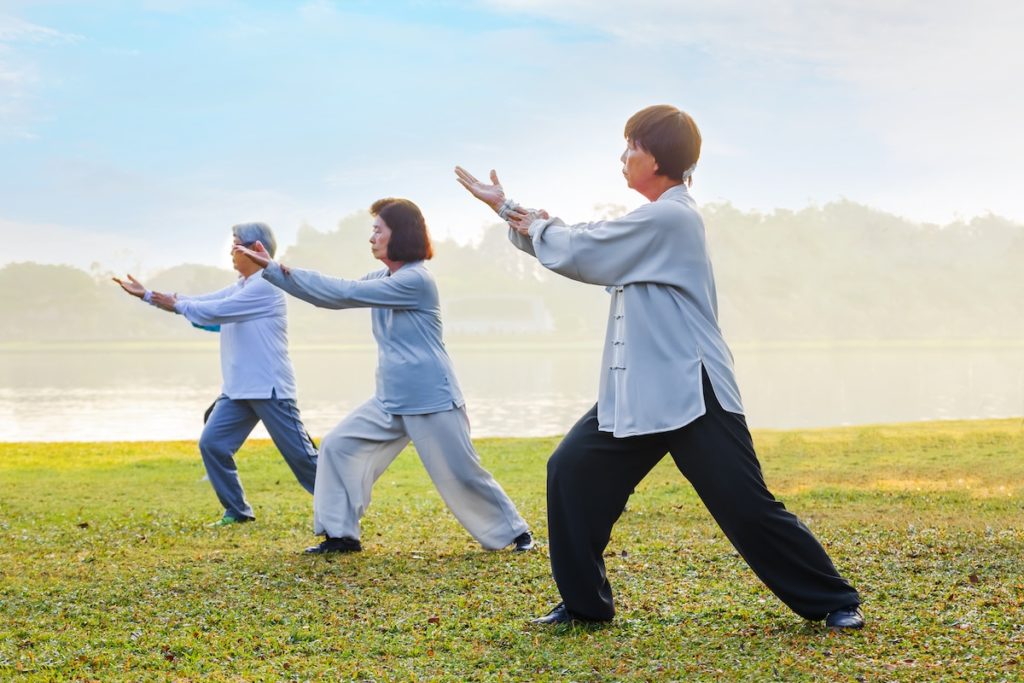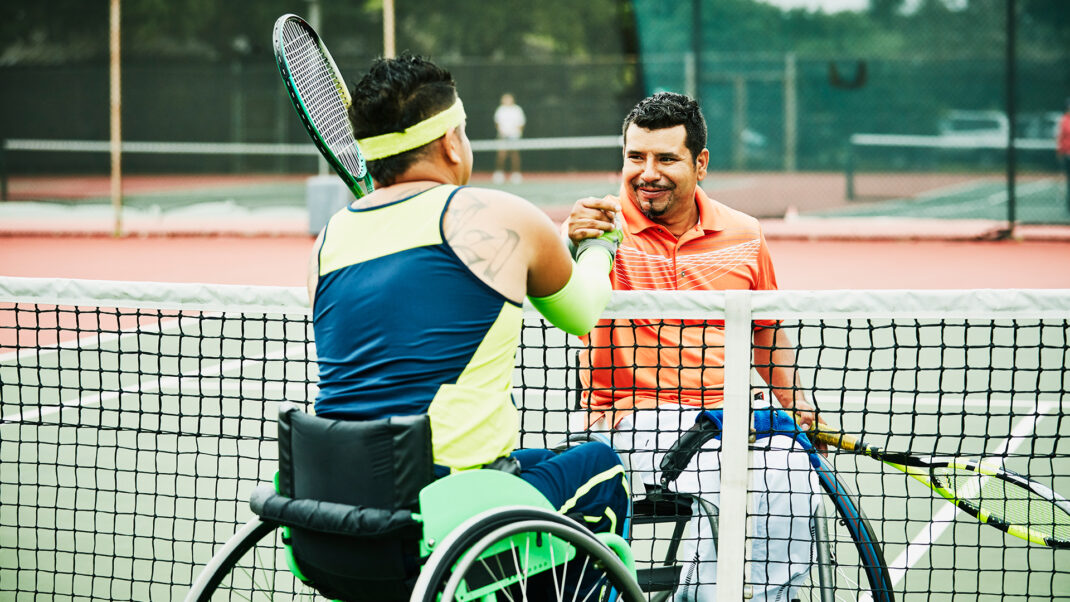Tai Chi: The Perfect Balance for Aging Adults
The Chinese exercise form combines movement and meditation to help clients prevent falls and preserve cognitive function.
| Earn 1 CEC - Take Quiz
Earn 1 CEC - Take Quiz

Why tai chi?
These Chinese movement patterns have been around for centuries. In recent years, study after study has proven the benefits of tai chi—particularly for older exercisers—yet most fitness professionals seem to know little about it.
That’s too bad, because just about any fitness client can learn tai chi, and any fitness professional can teach it. Like other types of exercise, tai chi simply requires you to learn its movements and experience its benefits.
Indeed, tai chi is a great fit for aging exercisers because it improves balance and enhances cognitive function, and both these outcomes decrease the risk of falls and boost overall well-being. If you master and ultimately teach tai chi, you can develop a competitive edge in appealing to this client demographic. Read on to learn what you need to know.
A Proven Choice for Older Clients
Scientists have extensively studied the benefits of tai chi (see the sidebar “Key Tai Chi Benefits”). Just since 2010, more than 50 systematic reviews (including meta-analyses) published in scientific journals have documented tai chi’s value for elderly people at risk of falls. Tai chi has also been found to help cancer survivors (Miller & Taylor-Piliae 2014), Parkinson’s patients (Hackney & Wolf 2014) and others living with a broad spectrum of diseases and health conditions.
Let’s look more deeply at just a couple of the documented benefits for senior clients:
Balance and fall risk. The evidence suggests tai chi is an efficient, cost-effective way to improve static and dynamic balance, reduce fear of falling and potentially decrease the prevalence of falls in elderly people (Jimenez-Martin et al. 2013; Leung et al. 2011; Hackney & Wolf 2014; Liu & Frank 2010). Researchers caution that tai chi may not be as beneficial for frail and severely deconditioned older adults because they cannot perform the movements with sufficient intensity and duration to achieve significant protection against falls. Even so, a review in the American Journal of Chinese Medicine concluded that tai chi was more effective than other measures for preventing falls in at-risk populations (del-Pino-Casado, Obrero-Gaitan & Lomas-Vega 2016).
Cognition. Tai chi can improve cognition in older adults (Wu et al. 2013; Zheng et al 2015; Wayne et al. 2014; Miller & Taylor-Piliae 2014). Cognition includes executive function, language, learning and memory. Executive function is an umbrella term for a range of cognitive processes, including attention, working memory, problem-solving, processing speed, mental flexibility and other tasks. Although it is difficult to pin down exactly how tai chi improves cognition, it appears that practicing the movements can significantly enhance global and executive functioning in people with either no or mild cognitive impairment and may protect against cognitive decline.
We’ll need more research to understand how tai chi can do the most good for the most people. Studies published to date have not established the optimum number of forms or the optimum session duration or frequency. Nevertheless, the research clearly suggests that for older exercisers, tai chi should be one piece of an overall exercise program that includes individualized aerobic and strength training.
The Core Principles of Tai Chi
To learn tai chi, you need to understand several principles that trace to its roots as a centuries-old Chinese martial art. What started as a fast-moving combat technique had evolved by the 19th century into the slow, movement-meditation style we practice today (Bailey 2016). Of the handful of tai chi varieties, the most popular is the short-form, 24-movement Yang style (the full form has 108 movements).
Each of the varieties embodies core tai chi principles: columns; rotation; rooted and grounded; substantial and insubstantial; dan tian; and regulation. Here’s a quick look at each of them:
Columns. This principle emphasizes proper posture. Tai chi recognizes three columns—one runs from the top of your head through the center of your body, and the other two run from the shoulders through the hips. The idea is that you imagine being suspended from the ceiling, and everything falls naturally into alignment. While performing the forms (movements), you practice keeping your columns “intact” to maintain proper postural alignment.
Rotation. Proper rotation occurs along the central axis of the spine to maintain alignment. Tai chi trains the body to rotate properly and to involve the entire body—not just the limbs—in a movement.
Rooted and grounded. This concept encourages stability by maintaining firm contact with the ground. It begins with relaxing the body in all the postures and sinking into each posture as deeply as you can. “Rooted” does not mean glued to the ground: You should still have fluid movement throughout the form.
Substantial and insubstantial. Tai chi is a series of one-legged events. The weight-bearing leg, which should be rooted and grounded, is called “substantial.” The leg that is off the ground bears no weight and is “insubstantial.” When transitioning from one leg to another, you purposefully choose where to put your leg down, and then you shift your weight forward, keeping your columns intact. It should feel as though water were flowing from one side to the next. One side empties before it moves.
Dan tian. In exercise physiology terms, dan tian is the body’s center of mass, or center of gravity (roughly 2 inches in from your bellybutton and 2 inches down). Understanding dan tian helps you to keep your columns intact and maintain balance.
Regulation. Tai chi has five levels of learning, which progress in a systematic fashion. First you master the body (performing all movements correctly), and then you master your breathing, your mind, your chi (energy) and your spirit. You cannot regulate breathing before learning to regulate the body, and so forth. The ultimate goal is to overcome the need to consciously regulate. Once you have mastered regulation of breathing, doing the form comes so naturally that you’re no longer focused on breathing. That frees you to work on regulating the mind.
Yang-style tai chi has a 24-form sequence (see the sidebar “Yang-Style 24-Form Tai Chi”). Nature inspires many of the names of the forms, in accordance with Chinese tradition, but rest assured they are firmly grounded in biomechanics and kinesiology. The moves effectively challenge static and dynamic balance; weight-shifting with center-of-gravity control; somatosensation; coordination; gait; mobility; flexibility; and lower-body strength.
Each form is easy to learn, but there are subtle nuances to each movement that require a great deal of practice to fully master.
How Does One Learn Tai Chi?
Tai chi is best learned under the guidance of a teacher, but many people are self-taught. For instance, Dianne Bailey developed the Open the Door to Tai Chi System after years of experience with martial arts like tae kwon do and Brazilian jiu-jitsu. As she learned tai chi, she quickly realized that the martial arts traditionalists were essentially telling people that the only way to enjoy it was to embrace the entire martial arts lifestyle—which many people weren’t interested in.
Bailey started teaching tai chi classes in her gym and witnessed its transformative power for many types of people. She structured her classes to feel welcoming to casual exercisers and developed a style and sequence of teaching that enabled people to learn the movements and principles in a supportive, nonthreatening manner. Her success led her to create the Open the Door to Tai Chi certification for health and fitness professionals. To learn more about her program, visit www.taichisystem.com.
Mastering tai chi can take years, but you can learn the 24-form routine in a few weeks. Do not expect to be accurate and fluid in your movements at this early stage. As you practice, you will get better and better at regulating the body (movements). In another few weeks, you can probably start focusing on moving up the ladder to regulating your breathing and then your mind, chi and spirit. By this point, the physical movements will be natural and “automatic,” allowing you to experience the meditative benefits of tai chi. Of course, the more time and practice you put into it, the faster you’ll be able to progress to teaching others.
Teaching Tai Chi to Older Clients
Although we put tai chi in the mind-body category alongside Pilates and yoga, it’s truly in a category by itself: a “movement meditation” consisting of continuous, fluid and precisely controlled forms in a specific sequence. You can learn it, and you can teach it. And you can read the research to learn more about its many health benefits.
You owe it—to yourself and to your clients—to give tai chi a shot.
- Preparation
- Part the wild horse’s mane
- White crane spreads its wings
- Brush knee
- Play guitar
- Repulse the monkey
- Left ward-off sequence
- Right ward-off sequence
- Single whip
- Wave hands like clouds
- Single whip
- High pat on horse
- Right kick
- Smash and box the ears
- Left kick
- Left snake creeps, pheasant stands
- Right snake creeps, pheasant stands
- Fair lady works the shuttle
- Pick the needle up from the sea bottom
- Fan through the back
- Deflect, intercept and punch
- Pushing chi
- Return the tiger to the mountain
- Closing
Source: Bailey 2016.
Reduces
- risk of falls in older adults
- stress, anxiety and depression
- blood pressure
- joint pain
Improves
- energy and stamina
- mood and overall well-being
- aerobic capacity
- flexibility, balance and agility
- muscle strength and definition
- sleep quality
- immune system function
- congestive heart failure symptoms
Source: Mayo Clinic 2015
References
Bailey, D. 2016. Open the Door to Tai Chi. Denver: Lifelong Conditioning.
del-Pino-Casado, R., Obrero-Gaitan, E., & Lomas-Vega, R. 2016. The effect of tai chi on reducing the risk of falling: A systematic review and meta-analysis. American Journal of Chinese Medicine, 44 (5), 895–906.
Hackney, M.E., & Wolf, S.L. 2014. Impact of tai chi chu’an practice on balance and mobility in older adults: An integrative review of 20 years of research. Journal of Geriatric Physical Therapy, 37 (3), 127–135.
Jimenez-Martin, P.J., et al. 2013. A review of tai chi chuan and parameters related to balance. European Journal of Integrative Medicine, 5 (6), 469–75.
Leung, D.P.K., et al. 2011. Tai chi as an intervention to improve balance and reduce falls in older adults: A systematic review and meta-analytical review. Alternative Therapies in Health and Medicine, 17 (1), 40–48.
Liu, H., & Frank, A. 2010. Tai chi as a balance improvement exercise for older adults: A systematic review. Journal of Geriatric Physical Therapy, 33 (3), 103–109.
Mayo Clinic. 2015. Tai chi: A gentle way to fight stress. Accessed June 14, 2017: www.mayoclinic.org/healthy-lifestyle/stress-management/in-depth/tai-chi/art-20045184.
Miller, S.M., & Taylor-Piliae, R.E. 2014. Effects of tai chi on cognitive function in community-dwelling older adults: A review. Geriatric Nursing, 35 (1), 9–19.
Wayne, P.M., et al. 2014. Effect of tai chi on cognitive performance in older adults: Systematic review and meta-analysis. Journal of the American Geriatrics Society, 62 (1), 25–39.
Wu, Y., et al. 2013. The effects of tai chi exercise on cognitive function in older adults: A meta-analysis. Journal of Sport and Health Science, 2 (4), 193–203.
Zheng, G., et al. 2015. Tai chi and the protection of cognitive ability: A systematic review of prospective studies in healthy adults. American Journal of Preventative Medicine, 49 (1), 89–97.
Cody Sipe, PhD
Cody Sipe, PhD, is a respected authority on fitness for older adults with 25 years in the industry. He is a professor, researcher, international educator and co-founder of the Functional Aging Institute. Cody is currently an associate professor and director of clinical research in the doctoral physical therapy program at Harding University. He was recognized as the IDEA Program Director of the Year in 2005 and was a finalist for the IDEA Fitness Innovator of the Year award in 2019.






